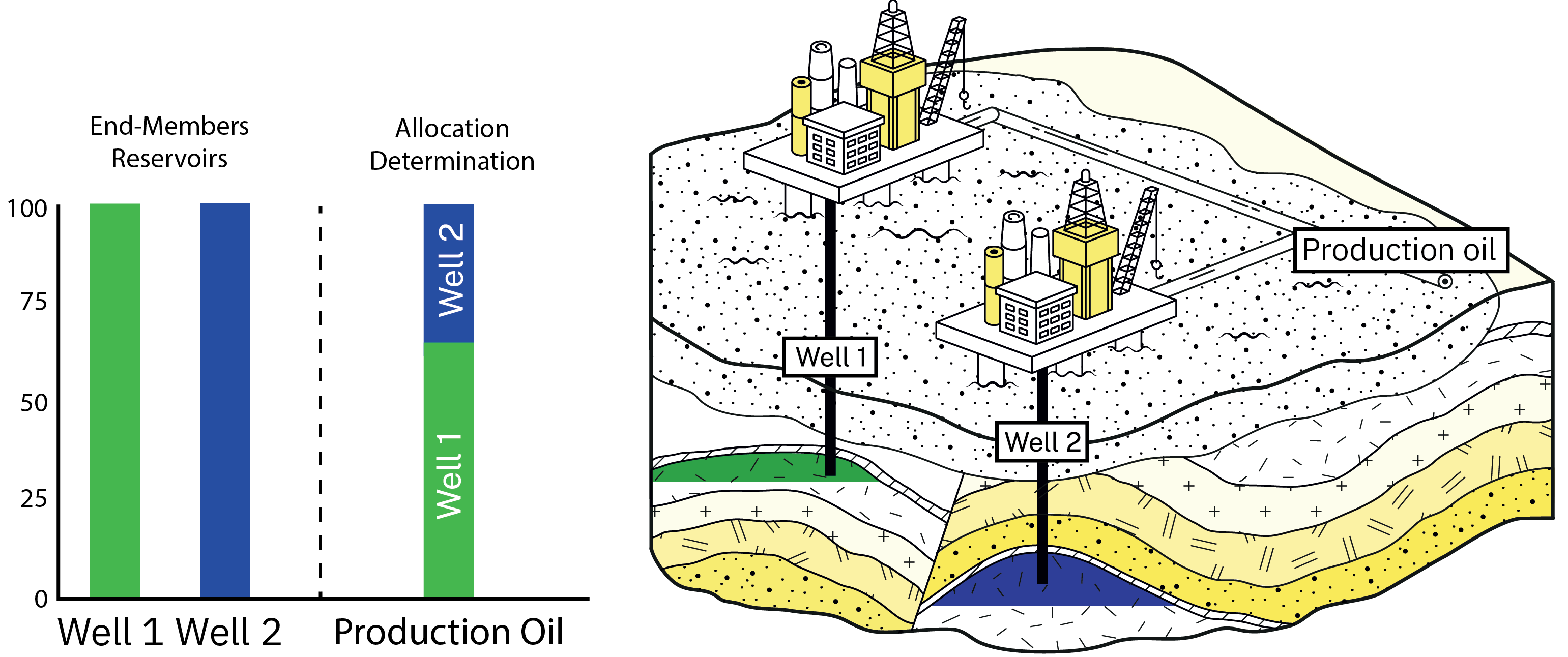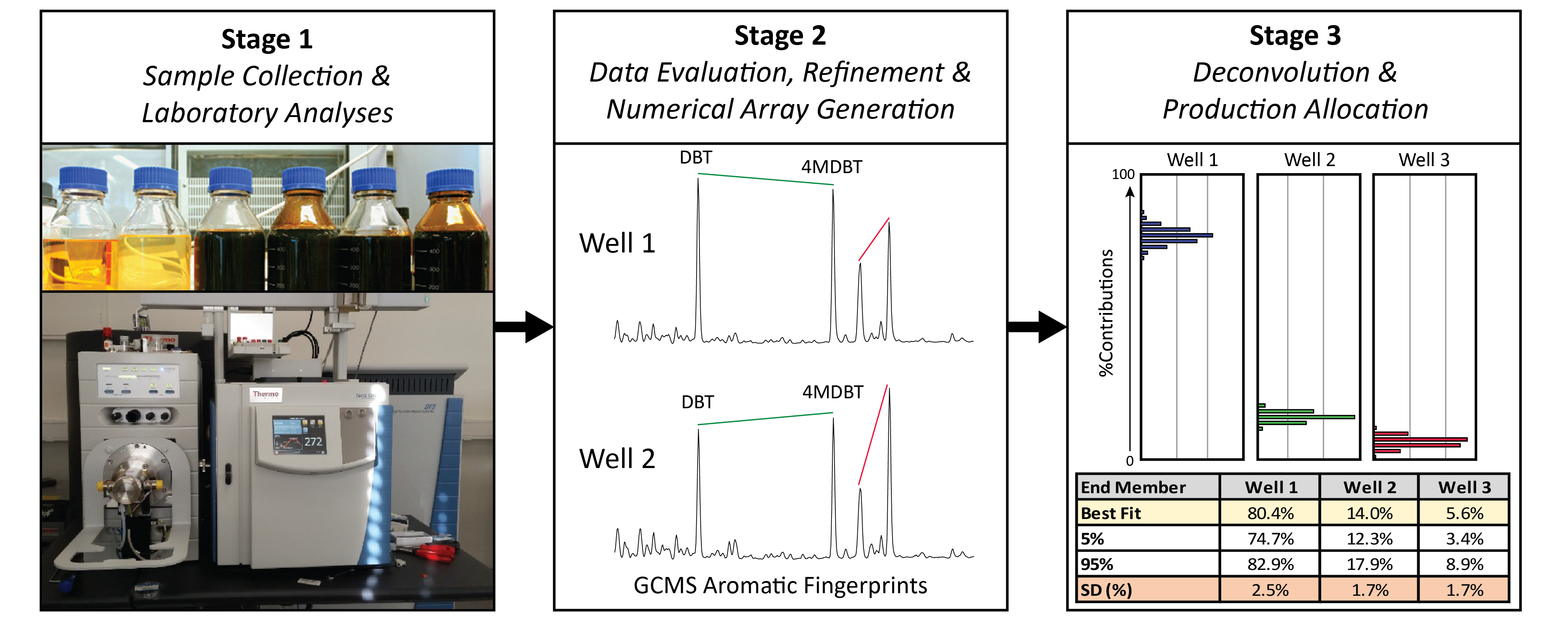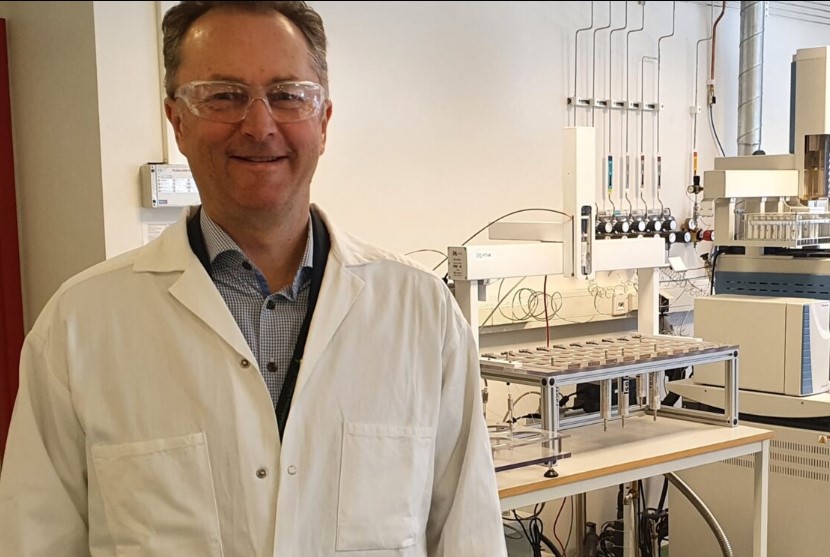Geochemical fingerprinting for production allocation of oil, gas or water is a well-established workflow in conventional reservoirs for both subsurface and topside facilities applications. These methodologies have been in existence for >30 years, during which time various analytical methods, data pre-processing and treatment approaches have been applied. Geochemical methods utilise the ‘natural’ tracers, e.g. fingerprints, preserved within fluid samples as opposed to requiring the introduction of ‘artificial’ tracers into the wells, although in many projects the two methods are complementary.
Deployment of fluid fingerprinting workflows is underutilised in almost all major plays globally. The reasons for such limited deployment are variable but often stem from a lack of knowledge around geochemical approaches and a general misunderstanding of geochemistry as exclusively an ‘exploration/appraisal’ workflow.

The benefits of geochemical fingerprinting-based methods are low cost and the fact that no intervention is required to the production of hydrocarbons from a well. In addition, the methodology is applicable to a wide range of fields, irrespective of pressure, temperature, reservoir quality and reservoir fluid type.
Geochemical fingerprinting approaches require a minimum level of sample availability or data to proceed, specifically:
- Representative end-member samples from individual wells or reservoirs taken prior to commingling;
- End-member fingerprints that are sufficiently discrete to ensure unmixing is feasible and valid.
Therefore, by far the biggest challenge to the success of production allocation projects is access to representative end-members from which allocation work can be undertaken. Where geochemical approaches are considered early, during initial development, end-members are much more readily accessible. However, when this approach is an afterthought, then end-member availability becomes much more challenging. Hence, the earlier this approach is considered the better the chance of its successful deployment.
What is production allocation?
Production allocation is generally defined as the quantitative determination of the amount, or portion, of a commingled fluid that can be assigned to two or more individual fluid sources, also referred to as ‘end-members’. In conventional reservoirs, allocation is commonly utilised for assigning contributions into a pipeline from multiple wells, reservoirs and/or fields (Figure 1). Allocation contributions are representative of the time at which commingled wells are sampled, they are a snapshot in time, whereas evaluation of changes in contributions through time is generally referred to as time-lapse geochemistry (TLG) or production monitoring.
Other ways to Rome
However, other avenues for accessing end-member samples do exist, including public or proprietary databases as well as operators who may have sampled, and stored, the same or equivalent reservoirs. These avenues offer additional potential routes to ensure all possible end-members are analysed while also offering opportunities to evaluate any variability within end-member reservoirs themselves.
Care must be taken during sample collection, both for end-members and commingled production, to ensure good sample handling procedures and minimal contamination with oil-based drilling fluids (OBM). Both of these factors can potentially restrict the analytical approaches available and, in some cases, invalidate the use of crucial, if not irreplaceable, samples.
A successful production allocation study, once samples have been collected, consists of three stages:
- Determination of differences in the chemical composition of the end-member samples – and subsequent commingled samples – through identification of the appropriate analytical approach by using, for example, Gas Chromatography (GC) or Mass Spectrometry (MS);
- Data selection, pre-processing (e.g. selection of ratios & concentrations of components) and statistical treatment (e.g. Hierarchical Cluster Analysis, Principal Component Analysis) to build and refine the numerical array for deconvolution;
Determination of end-member contributions by solving equations (e.g. least squares best fit) and uncertainty estimation (e.g. Monte Carlo or Bootstrap methods).

No “one size fits all” approach
As noted above, the primary output from this workflow is end-member contributions (e.g. %A, %B, etc), along with an uncertainty estimate (+/- 5%). The level of uncertainty that should be expected in conventional projects varies – due to a wide array of project-specific factors – but with good separation of valid and discrete end members <5% should be possible.
In conventional projects, uncertainty is primarily tied to the inherent variability associated with the analytical approach utilised, which in itself is selected to maximise end-member definition. There is no ‘one size fits all’ analytical approach; different analyses are more appropriate for certain basins or fluid types (e.g. gas, condensate, black oil, biodegraded oils) than others, a point noted consistently across the literature on geochemical allocation workflows.
By far, the most common analytical approach for conventional allocation projects is whole oil and gas chromatography (GC). This is the most cost-effective analytical approach and generally requires no sample preparation, meaning data can be collected and evaluated rapidly. Deconvolution utilising GC fingerprints is possible and has been extremely successful in many projects.
In some cases, this analytical approach may prove insufficient in definitively separating ‘end-member’ fingerprints to the extent needed for allocation. Other possible challenges are that this method is readily impacted by the presence of drilling fluid contamination, sample handling procedures, and biodegradation, potentially restricting the range of compounds available for fingerprinting and subsequent allocation.
Heavier compounds
Where GC approaches alone are insufficient, gas chromatography mass spectrometry (GCMS) methods are generally the next logical analytical approach. These analytical methods are less impacted by contamination and sample handling processes as they are focused on the heavier, C15+ compounds. The specific MS approach adopted (e.g. saturates, aromatics, alkylbenzenes) is guided by a range of project, basin and formation specific factors including information on thermal maturity and organofacies.
Although challenges exist, primarily around viable end-member acquisition as discussed previously, production allocation via geochemical fingerprinting is a cost-effective approach, relying solely on the collection of fluid samples. These workflows are deployable across most fields, can be adapted to meet most project challenges and are comparable to mechanical meter-based methodologies at a fraction of the cost.





